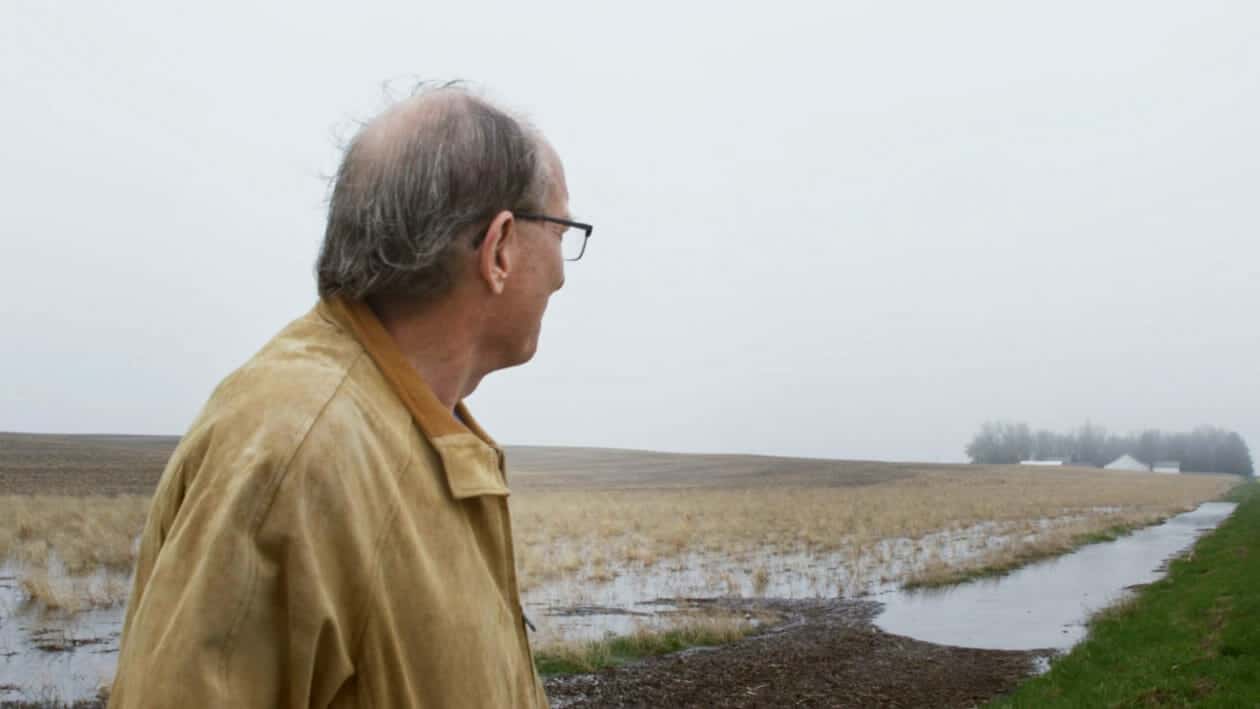

Iowa State Senator David Johnson has led the fight to reduce agricultural pollution of the state’s waters. Casey Beck
“Health trumps politics,” said Iowa State Senator David Johnson before taking the stage at a raucous rally in Des Moines last winter to support strengthening the state’s water quality. In the marble rotunda of the state capitol, he rose to denounce the nitrogen and phosphates that have been flowing in ever-increasing quantities into Iowa’s public water supplies — and was cheered by the small crowd of family farmers, concerned mothers, and his new political allies, the legislature’s drastically outnumbered Democrats. Johnson had been one of the longest-serving Republicans in Iowa until he left the party to become an independent in 2016 after defying it repeatedly on one of the most divisive issues in Iowa — the integrity of the state’s water.
Iowa’s nitrogen load has been accelerating despite more than $100 million spent by the federal and state governments to rein it in. Starting in 1999, the concentration of nitrogen in the state’s major waterways has increased almost 50 percent, according to a study from the University of Iowa, published last spring in PLOS One.
The battle over Iowa’s water had long been posed as one between rural and urban interests, until Johnson, whose district is one of the most thinly populated and heavily farmed in the state, came along.
In 2002, Senator Johnson co-authored one of the state’s key water statutes, the “Master Matrix,” which was supposed to establish health and safety guidelines for CAFOs and industrial farms in Iowa. By 2012 he was seeing how the relatively lax controls he had authored were being exploited, leaving his constituents vulnerable to the health consequences of escalating pollution from agricultural runoff. Nitrate pollution increased from about 200 million pounds in 2002 to more than a billion pounds in 2016. “I helped write this law in 2002,” he says, “and it’s terribly outdated with the current conditions that we’re seeing right now.”
Johnson describes himself as a moderate and a strong opponent of abortion. He is tall, loose-limbed, and acerbic. His concern over the health impacts of the state’s increasingly polluted water supplies has turned him into an unlikely leader of the fight now underway over the accelerating stresses on water in Iowa, where large industrial farms abut key waterways.
More than 750, or 58 percent, of the state’s rivers and streams do not meet federal water quality standards and are designated by the Iowa Department of Natural Resources (DNR) as too contaminated for swimming or consuming fish caught there — making a state once renowned for its lattice of waterways into a mess of inaccessible creeks, streams and lakes. Another 23 percent fall into a category of being “potentially impaired,” which the state defines as, “waters in need of further investigation.” Ninety-two percent of the nitrogen and 80 percent of phosphates in the state’s waterways, says the DNR, come from farms and animal feedlots.
All the water running through Johnson’s district — in the Floyd, Little Sioux, and Maple rivers — ultimately flows west into the Missouri River, which winds its way south to the Mississippi River, which then dumps the toxic legacy of Iowa farms into the Gulf of Mexico. It’s the same for rivers like the Des Moines and the Raccoon, which wind their way through Iowa and end at the Mississippi. For the last decade, Iowa has been the […]
Full article: In the Heart of the Corn Belt, an Uphill Battle for Clean Water
Rep. John Forbes: Iowa water quality bill is watered down
Iowa’s water quality problems: What you need to know
Iowa environmentalists scored a victory for water quality as 2017 ended
Lawsuit Dismissal Spells Bad News for Iowa Water Quality
Editorial: Iowa’s filthy waterways are a disgrace
Five gross things we used to dump in the Mississippi River — and what we’re dumping now
Clean water is essential for life, yet millions of Americans unknowingly consume contaminants through their…
Human brains contain higher concentrations of microplastics than other organs, according to a new study, and the…
From the Office of the Governor: In anticipation of a multi-day, significant atmospheric river in Northern California,…
From Governor Newsom: Scientists, water managers, state leaders, and experts throughout the state are calling…
Photo: A harmful algal bloom in Milford Lake, Kansas, made the water appear bright green.…
An expanded plastic foam coffee cup is at a donut shop in Monterey Park, California.…